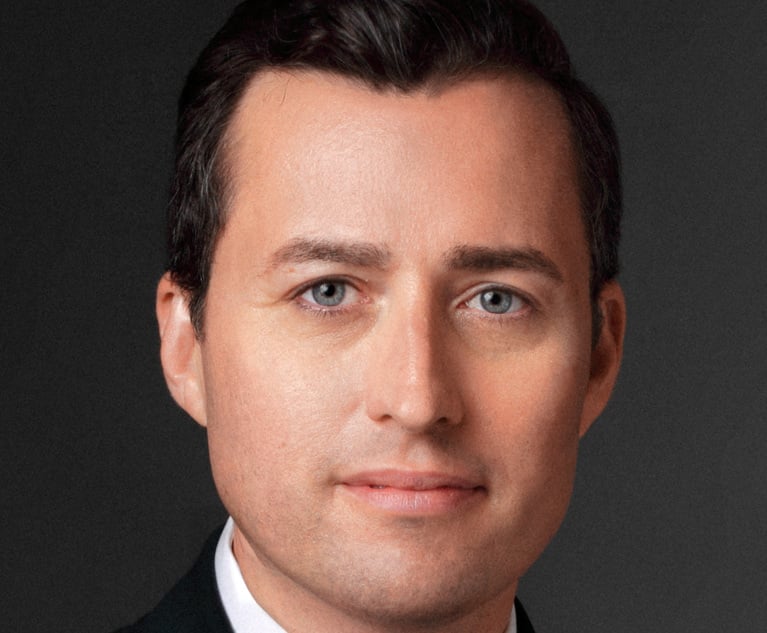Coverage Issues To Consider in Wake of Child Victims Act
The New York State Child Victims Act dramatically expanded the universe of claimants for which liability insurers—in particular historical commercial general liability and insurers issuing claims-made E&O policies—will be asked to pay defense and indemnity costs.
November 08, 2019 at 02:20 PM
8 minute read
 In August, the New York Courts' Chief Administrative Judge Hon. Lawrence K. Marks announced that NY courts would take the unusual step of developing standard case management and fast-tracking for sex abuse claims revived by CPLR §214-g (the NY State Child Victims Act) (NYCVA). NYCVA, which Gov. Andrew Cuomo had signed into law on Feb. 14, 2019, opened a one-year-long window beginning August 14th for sex abuse victims to file otherwise time-barred claims against perpetrators, employers, supervisors and others.
In August, the New York Courts' Chief Administrative Judge Hon. Lawrence K. Marks announced that NY courts would take the unusual step of developing standard case management and fast-tracking for sex abuse claims revived by CPLR §214-g (the NY State Child Victims Act) (NYCVA). NYCVA, which Gov. Andrew Cuomo had signed into law on Feb. 14, 2019, opened a one-year-long window beginning August 14th for sex abuse victims to file otherwise time-barred claims against perpetrators, employers, supervisors and others.
NYCVA exposes educational, religious, medical, and other defendants to tens of millions of dollars in liability and defense. The day NYCVA's window opened, more than 439 NYCVA claims were reportedly filed. The bigger picture is just as dramatic: The Catholic Archdiocese of New York stated in a June 2019 coverage complaint (discussed in this article) that, through its "Independent Reconciliation and Compensation Program," 323 claimants had received approximately $65 million in compensation; when the Diocese of Rochester [New York] filed for Chapter 11 bankruptcy protection last month, it specifically referenced NYCVA in estimating liabilities between $100 and $500 million; and news reports cited one NYCVA plaintiffs' lawyer to say he expected between 150 and 200 NYCVA suits would be filed against the Rochester diocese alone before the window closes in August 2020.
NYCVA also dramatically expanded the universe of claimants for which liability insurers—in particular historical commercial general liability and insurers issuing claims-made E&O policies—will be asked to pay defense and indemnity costs.
Challenges for Insurers
For insurers, there are several challenging aspects to NYCVA exposure. The first stems from the aggressive regulatory posture announced by the NYS Department of Financial Services (NYDFS) pertaining to NYCVA. NYDFS's September 12th Insurance Circular Letter starkly reminded insurers—as if they did not already know—of their role and exposure pertaining to NYCVA claims. NYDFS also told insurers they are expected to "cooperate fully with [NYCVA's] intent" and "do more than the minimum required" in handling these claims. NYDFS described "the importance of victims' claims being timely reviewed by courts, alternative dispute resolution entities, or other tribunals, to reach appropriate resolutions and provide remedial benefits to victims." Insurers were warned: "Do not demand verification of facts unless there are good reasons to do so" (without adding NYDFS's view of what constitutes "good reasons"). Finally, NYDFS outlined its expansive view of New York's insurer "fair claims" scheme. Later, NYDFS issued a separate reminder that NYDFS is available as a "resource" in connection with NYCVA claims.
NYDFS's posture raised the stakes for insurers already in a daunting claims management environment. On their own, these claims would create immense challenges for insurers, including potential insurer insolvencies, lost or destroyed policies and claim documents, deceased or unavailable witnesses, varying retentions, deductibles and limits across numerous policy periods, and other issues. NYCVA claims may also involve multiple perpetrators, defendants, locations, and instances or patterns of sex abuse taking place over many years.
The NY Archdiocese had complained, in opposing NYCVA's enactment that it "would force institutions to defend alleged conduct decades ago about which they have no knowledge, and in which they had no role, potentially involving employees long retired, dead or infirm, based on information long lost, if it ever existed." Now, insurers face those challenges amidst the NYCVA avalanche. As countless Gordian knots are unwound in complex NYCVA fact patterns, insurers must make prompt, coverage-related determinations while under seemingly intense scrutiny by NY regulators that implies that speed trumps other, legitimate considerations (including bargained-for insurance contracts and settled NY case law).
Early NYCVA Coverage Litigation
Whatever NYDFS's beliefs about how insurers should conduct themselves in handling NYCVA obligations, coverage litigation involving insurance first principles began before the one-year window opened. In June 2019, the Catholic Archdiocese of New York filed a lawsuit against 32 defendant insurers and groups pertaining to known or anticipated claims against "parishes, schools and other Roman Catholic entities." Archdiocese suit, N.Y. Sup. Ct., N.Y. Cty. Index No. 653772/2019.
The Archdiocese suit seeks a declaration of coverage and damages pertaining to unspecified "claims and lawsuits alleging sexual abuse that will be asserted" against the Archdiocese stemming from NYCVA. The suit seeks a declaration of coverage broadly affecting the Archdiocese's NYCVA claims and starts by outlining a NYCVA suit filed by John Michael Norman in April 2019. Norman's allegations seem to typify NYCVA claims, including approximated, multiple periods of abuse decades ago at unspecified locations and conduct by two alleged clergy perpetrators. Norman asserts negligence, breach of fiduciary duty and other claims, alleging in conclusory fashion that the Archdiocese knew or should have known about the alleged abuse.
The Archdiocese suit challenges a disclaimer denying defense or indemnity obligations on the grounds that the alleged injury in Norman was "expected and/or intended from the standpoint of the Archdiocese" and therefore do not constitute an "occurrence' under policies issued in by INA.
Coverage Issues
The Archdiocese suit focuses on a few issues pertaining to the foundational "fortuity" requirement established in the NY Court of Appeals' 2002 Consolidated Edison case ("the requirement of a fortuitous loss is a necessary element of insurance policies based on either an 'accident' (or 'occurrence"), even those without "expected or intended" exclusions. But the Archdiocese and Norman suits typify coverage-related claims and allegations giving rise to a Pandora's Box of coverage issues insurers and insureds must consider. The following highlights some of them.
(1) Type of Coverage Available. Commercial General Liability (CGL) coverage will be the focus of NYCVA claims, since NYCVA specifically revives claims for abuse and injury that took place years ago. Current, claims-made Employment Practices Liability Insurance (EPLI) or Directors & Officers (D&O) may also cover at least some alleged conduct and provide defense coverage.
(2) Lost or Incomplete Policies. NY law holds that an insured's ignorance of its insurance carrier constitutes "gross negligence" and is not a valid excuse for the provide the carrier with timely notice. See, e.g., Eagle Ins. Co. v. Garcia, 280 A.D.2d 476, 477 (2d Dept. 2001). An insured, not its insurer, bears responsibility for retaining policy documentation. See, e.g., Olin Corp. v. Ins. Co. of North America, 966 F.2d 718, 724-25 ("it is the responsibility of the insured, not the insurance company, to keep track of which carriers have provided it with liability insurance"). Further, when facing a lost policy situation and potential notice obligations, an insured must show "reasonably diligent efforts" to ascertain coverage. Winstead v. Uniondale Union Free School Dist., 201 A.D.2d 721, 723-24 (2d Dept. 1994); McPartlon v. Continental Cas. Co., 2017 WL 4286280 (N.D.N.Y. Sept. 26, 2017), at *4. Despite this, the September 12th Circular told insurers to "seek out copies of relevant policies of current and prior policyholders that the addressee knows or has reason to know may be subject to CVA-related legal claims." That approach suggests turning years of NY case law on its head.
(3) Late Notice. 2008 amendments to NY Insurance Law §3420 provide that, with respect to policies issued on or after Jan. 17, 2009, an insurer must demonstrate prejudice in order to disclaim coverage on late notice grounds. For policies issued before this date, there is no requirement for an insurer to demonstrate prejudice. NY law recognizes an insured must provide once it "could glean a reasonable possibility of the policy's involvement" based on "the information available relative to the accident" (or "occurrence"). See, e.g., Paramount Ins. Co. v. Rosedale Gardens, 293 A.D.2d 235, 240 (1st Dept. 2002). Although a generic form of notice of alleged abuse sent to an NYCVA defendant years ago may have triggered notice obligations, that question defies quick, bright-line determinations. See, e.g., McPartlon, 2017 WL 4286280 at *3-4. For NYCVA claims, already-challenging notice questions must be investigated in the face of confusing regulatory pressure.
(4) Defense and Cost-Sharing. The Archdiocese suit alleges that INA (Chubb) owes the Archdiocese a defense in Norman since the Norman allegations "do not unequivocally allege that the Archdiocese expected or intended all of the alleged abuse." Under NY law, an insurer's defense obligation is determined by the "four corners of the complaint" in tandem with "facts within the knowledge of the insurer" and is triggered unless there is "no possible factual or legal basis" for an indemnity obligation. See, e.g., Onesource Facility Services v. Golden Plow, 2012 WL 6192668 (N.Y. Sup. Ct., NY Cty.). Along with these considerations, insurers must collaborate with other insurers having triggered policies, promptly retain and fund defense counsel, arrange cost-sharing, and address periods of lost or missing coverage, insurer insolvencies, and other issues.
Conclusion
The foregoing highlights only a few coverage issues for insurers impacted by NYCVA. Insured bankruptcies will further complicate all claim administration issues. In all events, insurers' efforts to adjust and pay claims consistent with their contractual obligations was made more difficult by NYDFS's approach.
Bill Lalor is an attorney in Early Sullivan Wright Gizer & McRae's New York office.
This content has been archived. It is available through our partners, LexisNexis® and Bloomberg Law.
To view this content, please continue to their sites.
Not a Lexis Subscriber?
Subscribe Now
Not a Bloomberg Law Subscriber?
Subscribe Now
NOT FOR REPRINT
© 2025 ALM Global, LLC, All Rights Reserved. Request academic re-use from www.copyright.com. All other uses, submit a request to [email protected]. For more information visit Asset & Logo Licensing.
You Might Like
View All
Insurance Company Sues Over 180 Health Care Providers for Fraud Under RICO
3 minute read
New York Court of Appeals Tightens Pleading Standards Against Insurance Policyholder
7 minute read
Amid Growing Litigation Volume, Don't Expect UnitedHealthcare to Change Its Stripes After CEO's Killing
6 minute read
GE Agrees to $362.5M Deal to End Shareholder Claims Over Power, Insurance Risks
2 minute readTrending Stories
- 1Avantia Publicly Announces Agentic AI Platform Ava
- 2Shifting Sands: May a Court Properly Order the Sale of the Marital Residence During a Divorce’s Pendency?
- 3Joint Custody Awards in New York – The Current Rule
- 4Paul Hastings, Recruiting From Davis Polk, Adds Capital Markets Attorney
- 5Chancery: Common Stock Worthless in 'Jacobson v. Akademos' and Transaction Was Entirely Fair
Who Got The Work
J. Brugh Lower of Gibbons has entered an appearance for industrial equipment supplier Devco Corporation in a pending trademark infringement lawsuit. The suit, accusing the defendant of selling knock-off Graco products, was filed Dec. 18 in New Jersey District Court by Rivkin Radler on behalf of Graco Inc. and Graco Minnesota. The case, assigned to U.S. District Judge Zahid N. Quraishi, is 3:24-cv-11294, Graco Inc. et al v. Devco Corporation.
Who Got The Work
Rebecca Maller-Stein and Kent A. Yalowitz of Arnold & Porter Kaye Scholer have entered their appearances for Hanaco Venture Capital and its executives, Lior Prosor and David Frankel, in a pending securities lawsuit. The action, filed on Dec. 24 in New York Southern District Court by Zell, Aron & Co. on behalf of Goldeneye Advisors, accuses the defendants of negligently and fraudulently managing the plaintiff's $1 million investment. The case, assigned to U.S. District Judge Vernon S. Broderick, is 1:24-cv-09918, Goldeneye Advisors, LLC v. Hanaco Venture Capital, Ltd. et al.
Who Got The Work
Attorneys from A&O Shearman has stepped in as defense counsel for Toronto-Dominion Bank and other defendants in a pending securities class action. The suit, filed Dec. 11 in New York Southern District Court by Bleichmar Fonti & Auld, accuses the defendants of concealing the bank's 'pervasive' deficiencies in regards to its compliance with the Bank Secrecy Act and the quality of its anti-money laundering controls. The case, assigned to U.S. District Judge Arun Subramanian, is 1:24-cv-09445, Gonzalez v. The Toronto-Dominion Bank et al.
Who Got The Work
Crown Castle International, a Pennsylvania company providing shared communications infrastructure, has turned to Luke D. Wolf of Gordon Rees Scully Mansukhani to fend off a pending breach-of-contract lawsuit. The court action, filed Nov. 25 in Michigan Eastern District Court by Hooper Hathaway PC on behalf of The Town Residences LLC, accuses Crown Castle of failing to transfer approximately $30,000 in utility payments from T-Mobile in breach of a roof-top lease and assignment agreement. The case, assigned to U.S. District Judge Susan K. Declercq, is 2:24-cv-13131, The Town Residences LLC v. T-Mobile US, Inc. et al.
Who Got The Work
Wilfred P. Coronato and Daniel M. Schwartz of McCarter & English have stepped in as defense counsel to Electrolux Home Products Inc. in a pending product liability lawsuit. The court action, filed Nov. 26 in New York Eastern District Court by Poulos Lopiccolo PC and Nagel Rice LLP on behalf of David Stern, alleges that the defendant's refrigerators’ drawers and shelving repeatedly break and fall apart within months after purchase. The case, assigned to U.S. District Judge Joan M. Azrack, is 2:24-cv-08204, Stern v. Electrolux Home Products, Inc.
Featured Firms
Law Offices of Gary Martin Hays & Associates, P.C.
(470) 294-1674
Law Offices of Mark E. Salomone
(857) 444-6468
Smith & Hassler
(713) 739-1250






